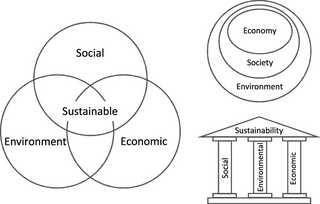
Sustainable development is an organizing principle that aims to meet human development goals while also enabling natural systems to provide necessary natural resources and ecosystem services to humans. The desired result is a society where living conditions and resources meet human needs without undermining the planetary integrity and stability of the natural system. Sustainable development tries to find a balance between economic development, environmental protection, and social well-being. The Brundtland Report in 1987 defined sustainable development as "development that meets the needs of the present generation without compromising the ability of future generations to meet their own needs". The concept of sustainable development nowadays has a focus on economic development, social development and environmental protection for future generations.
Overconsumption describes a situation where a consumer overuses their available goods and services to where they can't, or don't want to, replenish or reuse them. In microeconomics, this may be described as the point where the marginal cost of a consumer is greater than their marginal utility. The term overconsumption is quite controversial in use and does not necessarily have a single unifying definition. When used to refer to natural resources to the point where the environment is negatively affected, it is synonymous with the term overexploitation. However, when used in the broader economic sense, overconsumption can refer to all types of goods and services, including manmade ones, e.g. "the overconsumption of alcohol can lead to alcohol poisoning". Overconsumption is driven by several factors of the current global economy, including forces like consumerism, planned obsolescence, economic materialism, and other unsustainable business models and can be contrasted with sustainable consumption.
An ecological or environmental crisis occurs when changes to the environment of a species or population destabilizes its continued survival. Some of the important causes include:
Eco-capitalism, also known as environmental capitalism or (sometimes) green capitalism, is the view that capital exists in nature as "natural capital" on which all wealth depends. Therefore, governments should use market-based policy-instruments to resolve environmental problems.

Environmental degradation is the deterioration of the environment through depletion of resources such as quality of air, water and soil; the destruction of ecosystems; habitat destruction; the extinction of wildlife; and pollution. It is defined as any change or disturbance to the environment perceived to be deleterious or undesirable. Environmental degradation process amplify the impact of environmental issues leave lasting impacts on the environment.

Land development is the alteration of landscape in any number of ways such as:

Environmental planning is the process of facilitating decision making to carry out land development with the consideration given to the natural environment, social, political, economic and governance factors and provides a holistic framework to achieve sustainable outcomes. A major goal of environmental planning is to create sustainable communities, which aim to conserve and protect undeveloped land.
Human overpopulation describes a concern that human populations may become too large to be sustained by their environment or resources in the long term. The topic is usually discussed in the context of world population, though it may concern individual nations, regions, and cities.
The following outline is provided as an overview of and topical guide to technology:
The following outline is provided as an overview of and topical guide to ecology:
Bright green environmentalism is an ideology based on the belief that the convergence of technological change and social innovation provides the most successful path to sustainable development.

The following outline is provided as an overview of and topical guide to sustainability:

Sustainability is a social goal for people to co-exist on Earth over a long time. Definitions of this term are disputed and have varied with literature, context, and time. Experts often describe sustainability as having three dimensions : environmental, economic, and social, and many publications emphasize the environmental dimension. In everyday use, sustainability often focuses on countering major environmental problems, including climate change, loss of biodiversity, loss of ecosystem services, land degradation, and air and water pollution. The idea of sustainability can guide decisions at the global, national, and individual levels. A related concept is sustainable development, and the terms are often used to mean the same thing. UNESCO distinguishes the two like this: "Sustainability is often thought of as a long-term goal, while sustainable development refers to the many processes and pathways to achieve it."

Sustainable gardening includes the more specific sustainable landscapes, sustainable landscape design, sustainable landscaping, sustainable landscape architecture, resulting in sustainable sites. It comprises a disparate group of horticultural interests that can share the aims and objectives associated with the international post-1980s sustainable development and sustainability programs developed to address that humans are now using natural biophysical resources faster than they can be replenished by nature.

Environmental issues are disruptions in the usual function of ecosystems. Further, these issues can be caused by humans or they can be natural. These issues are considered serious when the ecosystem cannot recover in the present situation, and catastrophic if the ecosystem is projected to certainly collapse.
Environmental governance (EG) consists of a system of laws, norms, rules, policies and practices that dictate how the board members of an environment related regulatory body should manage and oversee the affairs of any environment related regulatory body which is responsible for ensuring sustainability (sustainable development) and manage all human activities—political, social and economic. Environmental governance includes government, business and civil society, and emphasizes whole system management. To capture this diverse range of elements, environmental governance often employs alternative systems of governance, for example watershed-based management. Obviously, in fact the EG arrangements are very diversed and not at all as inclusive as we could wish them to be.

The following outline is provided as an overview of and topical guide to geography:

The 2030 Agenda for Sustainable Development, adopted by all United Nations members in 2015, created 17 world Sustainable Development Goals (SDGs). They were created with the aim of "peace and prosperity for people and the planet..." They state that ending poverty and other deprivations, goes alongside strategies that improve health and education, reduce inequality, and increase economic growth – while tackling climate change and working to preserve oceans and forests. The SDGs emphasize the interconnected environmental, social and economic aspects of sustainable development by putting sustainability at their center.

Land change science refers to the interdisciplinary study of changes in climate, land use, and land cover. Land change science specifically seeks to evaluate patterns, processes, and consequences in changes in land use and cover over time. The purpose of land change science is to contribute to existing knowledge of climate change and to the development of sustainable resource management and land use policy. The field is informed by a number of related disciplines, such as remote sensing, landscape ecology, and political ecology, and uses a broad range of methods to evaluate the patterns and processes that underlie land cover change. Land change science addresses land use as a coupled human-environment system to understand the impacts of interconnected environmental and social issues, including deforestation and urbanization.
Sustainable population refers to a proposed sustainable human population of Earth or a particular region of Earth, such as a nation or continent. Estimates vary widely, with estimates based on different figures ranging from 0.65 billion people to 9.8 billion, with 8 billion people being a typical estimate. Projections of population growth, evaluations of overconsumption and associated human pressures on the environment have led to some to advocate for what they consider a sustainable population. Proposed policy solutions vary, including sustainable development, female education, family planning and broad human population planning.










